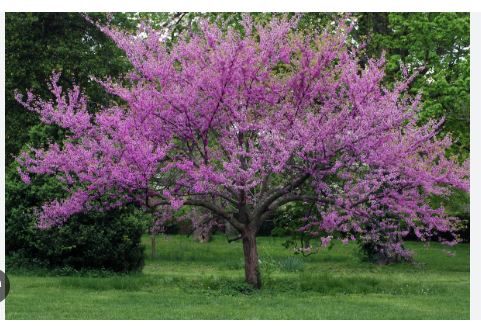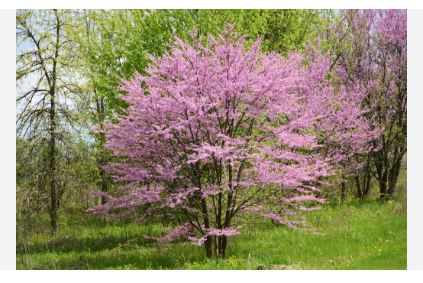
The Eastern Redbud, scientifically known as Cercis canadensis, belongs to the Fabaceae family, commonly referred to as the legume or pea family. It is part of the genus Cercis, which includes several species of redbuds native to North America, Europe, and Asia.
The species is divided into three subspecies: canadensis, texensis, and mexicana, with canadensis being the most widespread. The genus name Cercis derives from the Greek word kerkis, meaning weaver’s shuttle, alluding to the shape of its seed pods. As a member of the Caesalpinioideae subfamily, it shares traits with other legumes, such as nitrogen-fixing capabilities and pod-producing flowers.
Eastern Redbud is a small deciduous tree or large shrub, typically growing 20–30 feet tall with a spread of 25–35 feet. It is easily recognized by its vibrant pink to purple pea-like flowers, which bloom in early spring before the leaves emerge, often directly on branches and trunks (cauliflory).
The heart-shaped leaves, 3–5 inches long, are dark green, turning yellow in fall, though fall color is inconsistent. The bark is smooth and dark when young, becoming scaly with reddish undertones as it matures. After flowering, it produces flat, 2–4-inch seed pods that turn brown and persist into winter. Cultivars may feature white flowers, purple foliage, or weeping forms.
Native to eastern and central North America, Cercis canadensis ranges from southern Michigan and southern Ontario south to central Mexico, east to central Florida, and west to New Mexico. It is an understory tree, commonly found in mixed forests, along woodland edges, stream banks, and limestone bluffs.
The species thrives in a variety of habitats, from moist bottomlands to dry ridges, demonstrating its adaptability. Subspecies texensis (Texas Redbud) occurs in Oklahoma, Texas, and northeastern Mexico, while mexicana is found in west Texas and adjacent Mexico. It is absent from the Gulf and Atlantic Coastal Plains and is extinct in parts of southern Ontario.
Eastern Redbud is hardy in USDA Zones 4–9, showcasing excellent cold tolerance in northern regions and adaptability to heat in southern climates. The ‘Northern Strain’ or ‘Minnesota Strain’ extends its hardiness to Zone 4, surviving harsh winters. In hotter regions, such as the lower Midwest or southern zones, it benefits from partial shade to mitigate summer stress. Subspecies texensis and mexicana are better suited to arid conditions and tolerate high salinity, making them ideal for southwestern landscapes. The tree struggles in areas west of Kansas and Colorado due to insufficient rainfall.
Eastern Redbud is primarily valued as an ornamental tree, prized for its early spring blooms and heart-shaped foliage, making it a favorite in gardens, parks, and urban landscapes. It serves as a focal point in residential yards, street plantings, or woodland gardens, with cultivars like ‘Forest Pansy’ and ‘Ruby Falls’ offering unique foliage or forms.
Ecologically, its flowers provide critical early-season nectar and pollen for bees, butterflies, and hummingbirds, while seed pods feed birds and small mammals. In traditional uses, Native Americans consumed the flowers raw or boiled and used twigs for seasoning or dye. The tree’s compact size and pollinator support make it a versatile choice for sustainable landscaping.

Culivation of Eastern Redbud
Choose the Right Location
Select a site with full sun to partial shade, as Eastern Redbud thrives with at least 6 hours of sunlight daily for optimal flowering. In hotter climates (Zones 8–9), afternoon shade helps reduce heat stress. Ensure the location has enough space for the tree’s mature size, typically 20–30 feet tall and 25–35 feet wide, and avoid areas prone to waterlogging.
Test and Prepare the Soil
Eastern Redbud prefers well-drained, fertile soil with a pH of 6.0–7.5, though it tolerates slightly alkaline or acidic conditions. It adapts to various soil types, including loam, clay, or sandy soils, but struggles in heavy, poorly drained clay. Conduct a soil test to check pH and nutrient levels, amending with compost or organic matter to improve drainage and fertility if needed.
Plant at the Right Time
Plant in early spring or fall to allow roots to establish before extreme heat or cold. Dig a hole twice as wide and as deep as the root ball, ensuring the root collar sits at or slightly above ground level. Backfill with native soil mixed with compost, water thoroughly, and mulch to retain moisture and regulate soil temperature.
Water Consistently During Establishment
Keep the soil consistently moist but not soggy for the first 1–2 years after planting. Water deeply once or twice weekly, providing 1–2 inches of water, especially during dry spells. Once established, Eastern Redbud is moderately drought-tolerant but benefits from occasional deep watering during prolonged droughts.
Mulch to Conserve Moisture
Apply a 2–3-inch layer of organic mulch, such as wood chips or shredded bark, around the base, extending to the drip line but keeping it 2–3 inches from the trunk to prevent rot. Mulch retains soil moisture, suppresses weeds, and insulates roots against temperature extremes, particularly in winter or hot summers.
Fertilize Sparingly
Eastern Redbud typically doesn’t require heavy fertilization, as it fixes nitrogen through its legume-family roots. In nutrient-poor soils, apply a balanced, slow-release fertilizer (e.g., 10-10-10) in early spring before growth begins. Avoid over-fertilizing, which can lead to excessive foliage at the expense of blooms or increase disease susceptibility.
Prune for Structure and Health
Prune in late winter or early spring before bud break to shape the tree, remove dead or damaged branches, and improve air circulation. Young trees benefit from light pruning to establish a strong, open structure with 3–5 main branches. Remove suckers, water sprouts, or crossing branches, and avoid heavy pruning, which can stress the tree.
Monitor for Pests
Eastern Redbud is relatively pest-resistant but may attract leafhoppers, scale insects, or caterpillars. Inspect foliage regularly for signs of chewing, stippling, or sticky residue. Use insecticidal soap or neem oil for minor infestations, and encourage natural predators like ladybugs. Severe infestations may require consultation with a local extension service.
Manage Diseases Proactively
The tree is susceptible to fungal diseases like verticillium wilt, botryosphaeria canker, and anthracnose, especially in poorly drained or stressed conditions. Ensure proper drainage, avoid overhead watering, and remove infected branches promptly, sterilizing tools between cuts. If wilt or canker is suspected, consult an arborist, as these can be fatal.
Protect from Winter Stress
In colder regions (Zones 4–5), protect young trees from winter damage by wrapping trunks with burlap or tree guards to prevent sunscald and rodent damage. Apply a thicker mulch layer (4–6 inches) around the base in late fall to insulate roots. Avoid late-summer fertilization, which can stimulate tender growth vulnerable to frost.
Encourage Pollinator Activity
Eastern Redbud’s early spring blooms are a vital nectar source for bees, butterflies, and hummingbirds. Avoid using broad-spectrum pesticides during flowering to protect pollinators. Plant companion species like salvia or coneflowers to create a pollinator-friendly garden, enhancing ecological benefits.
Propagate for Expansion
Propagate Eastern Redbud through seeds, cuttings, or grafting, though seeds are the most common method. Collect seed pods in fall, scarify them to break dormancy, and soak in warm water before planting in spring. Cuttings from semi-hardwood can be taken in summer, while grafting is used for specific cultivars to ensure true-to-type plants.
Select Appropriate Cultivars
Choose cultivars suited to your climate and aesthetic preferences. Options include those with purple foliage, white flowers, or weeping forms. For colder regions, select ‘Northern Strain’ or ‘Minnesota Strain’ for enhanced hardiness. In hotter, arid areas, consider subspecies like texensis for better drought and heat tolerance.
Additional Tips
- Staking: Stake young trees in windy areas for the first year to stabilize roots, but remove stakes after establishment to encourage strong trunk development.
- Long-Term Care: Eastern Redbud has a moderate lifespan of 30–50 years. Regular monitoring for trunk damage or canker extends its vitality.
- Landscape Use: Use as a specimen tree, understory plant, or in groups for naturalized settings. Pair with spring bulbs or evergreens for year-round interest.